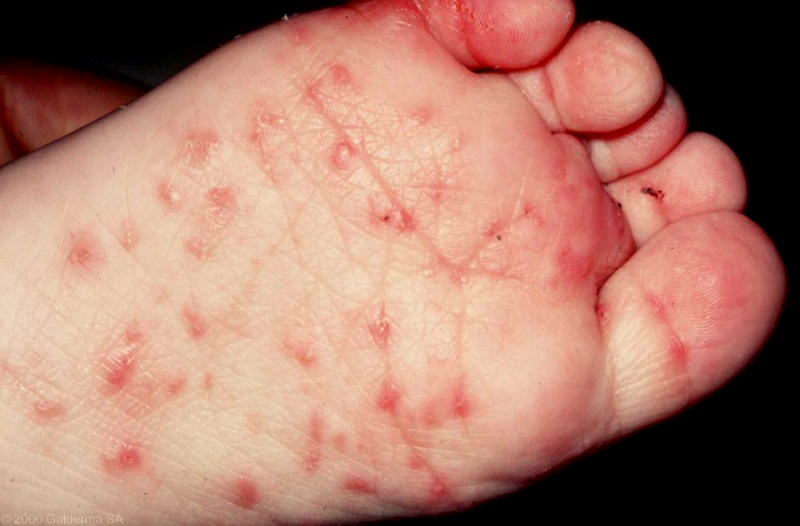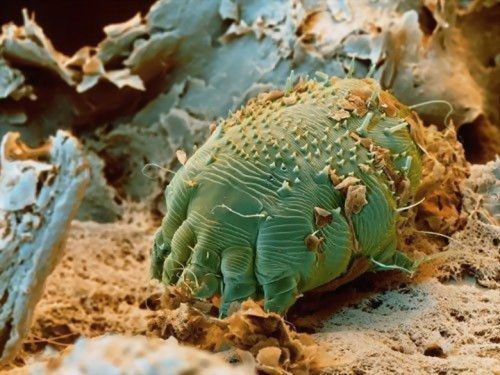Scabies “Seven Year Itch” – a Comeback in Children
I’m sure somebody like Steven King could make a good movie about this eight-legged bug, too small to be seen by the naked eye, but which lives by eating a persons top layer of skin and burrows through it to lay eggs that hatch in 4 days to an entirely new crop of bugs needing to feed.
Scarcoptes scabiei – Bug that causes ScabiesI’ve written about Scarcoptes scabiei, “human itch mite,” the Scabies mite before. It can spend a maximum of only 2 weeks without a human host to live upon and when doing so hides out in clothing, bed linens and sleeping bags etc..
Scabies, A Returning Problem
Adult female mites burrow through the skin to build and lay their “nests” of eggs, depositing dried fecal pellets behind them as they go. Males wander around the skin surface looking for an open burrow and female with which to mate. Hatchlings race through their infancy, childhood and adolescence within a week then begin their own eating and reproduction cycle.
Contrary to Abbot and Costello’s joke about the “seven year itch” you cannot “scratch real fast and get over it in five.” Resolution takes determined effort, medications and patience.
Called the “seven year itch” because it used to wax and wane in about seven year epidemic cycles, the little beasts are no longer sticking to that schedule and have become more onery and resistant to former remedies.
Contact Contagion
 Scabies on a child’s footUnlike many, if not most, other childhood infections, Scabies is not airborne; so, it most always requires actual skin-to-skin contact with an infected person. That, is the reason Scabies is usually a childhood and children’s families’ disease – kids are always touching and being touched.
Scabies on a child’s footUnlike many, if not most, other childhood infections, Scabies is not airborne; so, it most always requires actual skin-to-skin contact with an infected person. That, is the reason Scabies is usually a childhood and children’s families’ disease – kids are always touching and being touched.
Personal contact with someone who is infected with a female mite usually requires fairly prolonged and intimate contact; however, similar contact with infected clothing, bed linen and other personal articles has also been shown to be infectious. Scabies mites can not fly or jump and they move very slowly.
Pretty much it doesn’t matter if you’re the cleanest person in the world – if you are hugging on someone who has the unfortunate circumstance of being infected with scabies you’ll become infected too. AND, unless everyone in your intimate circumstance is treated completely, all at once, you can get it back… even several times!
Diagnosis
Diagnosis is not so easy. The “rash” often looks like pimples or mosquito bites and frequently can look like eczema, ringworm, athlete’s foot or jock itch (all Tinea infections).
Obviously, there is itching – Intense itching! And it’s usually worse at bedtime. When the problem is established, it’s easier to spot the tell-tale burrow with the mite at the end.
Burrows are more often found on the skin of the finger/toe webs, wrists, elbows, armpits, belt line, lower buttocks, female nipples and male genitals.
In the office, a doctor often does a “scraping” of the skin over a burrow in order to use his microscope to look for mites, their eggs or fecal matter; which is the most definitive way to diagnose the problem.
Treatment
It’s this “treatment thing” that has prompted yet a second article about scabies. Getting rid of Scabies is like swatting a fly and actually killing it – you’ve got to mean it! If you swing that fly-swatter half-heartedly thinking about the mess or trying to miss other things, it will merely fly away. BUT, if you take aim with clear intent and malice then swing like if you don’t it’s going to go land on your baby’s mouth – that sucker will be dead before it realized the look on your face.
 Toddler treated for scabiesGetting rid of Scabies is exactly the same way! The directions we give clearly state ALL family(contact) members, ALL skin surfaces and change/wash ALL bedding, clothing and contact items. Having trouble understanding the term “ALL” (because it takes effort) is what will get you into trouble!
Toddler treated for scabiesGetting rid of Scabies is exactly the same way! The directions we give clearly state ALL family(contact) members, ALL skin surfaces and change/wash ALL bedding, clothing and contact items. Having trouble understanding the term “ALL” (because it takes effort) is what will get you into trouble!
The mite has developed a fair amount of resistance to our former treatments, probably due to the second-chance the “natural selection” gives them when people only treat half-heartedly.
Today we use a lotion (Elimite etc.) containing Permethrin, a drug type found in the berries of the pyracantha bush, which paralyzes and kills mites and their eggs. Not significantly dangerous when used like the directions tell you, it still is a toxin that must be used correctly – especially in children.
The lotion is for use on the skin only, as soon as possible in the infection and needs to be massaged into the skin from the head to the soles of the feet – and everywhere in-between except for body orifices, like mouth, eyes, nose and genital/rectal openings. Under nails and in skin folds like between toes and fingers.
“Treating ALL family(contact) members” means every single family member, boy or girlfriend, extended family member who hugs and kisses on family members, or babysitter. It takes days/weeks for people to know they’ve been infected so even if they don’t yet have symptoms they should be treated.
“Treating ALL skin surfaces” literally means everywhere with few exceptions.
Children will most definitely need help and you cannot let over-modesty over-ride the treatment. To be blunt, all the genital area up to the tip of the penis and the edges of the vulva as well as between the buttocks to an inch or so of the anus should be covered with the lotion.
You’re the parent, figure this one out. Even older children need to be helped with their backs and full treatment needs to be verified/assured (especially in older children).
The consequence of missing even one area is often just like you never treated at all. Remember, the use of the lotion can only be repeated once so make the first one count! This is truly a case of “do it right the first time!”
After application of the lotion, any area that can accidentally touch a mouth or eye should then be covered with clothing and small children may need to wear gloves until the medicine is washed off with a bath or shower in ten hours. Going shorter than 8 hours may not kill the bugs. Going longer than 14 hours could become toxic.
And, “change/wash ALL bedding, clothing and contact items” means every piece of clothing that has been worn or touched by an infected person from the time they were infected to when the 10 hours of treatment are up. Mites are attracted to human skin scent so previously laundered clothing still in drawers and closets are ok but anything that may contain human scent should be washed/laundered thoroughly.
Bedding and items that can’t be laundered should be dry-cleaned, carpets thoroughly vacuumed; or, in the case of crawling infected persons, professionally cleaned. Non-launderable items (belts, shoes, purses, etc.) should be sprayed with Rid or R&C spray.
When a treated person takes their final bath or shower at the end of the treatment in 10 hours they must dry with newly laundered towels, dress in newly laundered clothing and that night sleep in newly laundered bedding.
Treatment of infants is a bit different and should be directed by a physician. Special precautions should be taken and treatment is tailored to each infant’s circumstances.
Treatment Success
The thing is: IF you work through ALL of the instructions, which are admittedly a bit bothersome, ONCE is nearly always enough. The vast majority of treatment failures are due to not treating everyone, not verifying that all the appropriate skin is covered thoroughly or not cleaning all contaminated surfaces. If you’re lazy… you loose!
Treating Scabies in Children and Teens
Treatment “Do’s”
- See a physician as soon as possible to begin treatment. Scabies is no reflection on your personal cleanliness even though you may be disgusted by the thought of bugs.
- Treat everybody exposed whether they are obviously infested or not. Incubation time is 6-8 weeks so symptoms may not show up right away. If you don’t treat everyone, it is as if you were never treated.
- Apply treatment from head to toes. If you wash your hands after application, you need to reapply the medication to your hands.
- Avoid getting the cream into your eyes, nose, mouth, or vagina. If the medication gets in your eyes, flush the eyes with plenty of water.
- Wash all personal items. The mite is attracted to scent. Clean clothes in closets or drawers are ok. Towels and bedding should be washed in a washing machine right away. Nothing needs to be boiled.
- Items you don’t want to wash may be put in the dryer on hot for 30 minutes or dry-cleaned.
- Rid or R&C spray may be used on things you can’t launder like belts, shoes, purses, etc.
- Pets do not have to be treated.
- Itching can continue for 2 or more weeks after successful treatment of the mite.
- Other things can also be put in a plastic bag and put in the garage or a storage area for 2 weeks. If the mites don’t get fed in a week, they usually die.
- Vacuum your entire living space.
- Call your doctor if the infection persists over two weeks after treatment; a secondary infection with redness, pus and tenderness develops; or, if treatment produces any symptoms of allergic reaction or toxicity – rash, swelling (i.e. face/tongue/throat), dizziness or trouble breathing.
Treatment “Don’ts”
- Don’t try to treat scabies with home remedies. Scrubbing with laundry detergent or hard soaps will only make it worse.
- Don’t use steroids or any other cream unless prescribed by a physician.
- Don’t repeat the treatment more than twice unless specifically told to by a physician.
- Don’t treat infants like the rest of the family – get specific instructions from your pediatrician.
Treatment Failures
Before you can call your treatment a failure you must wait long enough for your body to have rid itself of any of the dead mites’ bodies or feces. The treatment only kills the things, it doesn’t make them disappear. Your washing removes those on the outside of the skin but those left in the burrows still prove to be an irritant your body must remove naturally – up to four weeks.
Seeing new “burrows” after treatment shouldn’t happen if they’re all dead – even if the itching hasn’t stopped yet. And, some people develop an allergy to the mite’s body-parts so secondarily develop more itching and welts.
Calamine lotion or cortisone cream may provide relief during this time. Your doctor can prescribe other medications if needed to soothe the itching and should be seen if the conditions persists or worsens 2 weeks after treatment. If he/she hasn’t already done so, persistence or worsening would warrant a skin scraping and microscopic diagnosis.
Advertisement by Google
(sorry, only few pages have ads)

